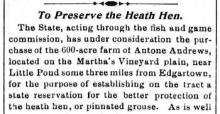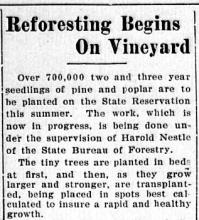As discussion begins to heat up around the issue of whether to build private golf clubs on the Vineyard, a citizens group has formed to oppose a golf club development planned for some 200 acres of land along the Edgartown Great Pond.
Called the Coalition for Preservation of Island Resources, the group includes a number of property owners near the planned golf course project. The key organizers for the group are Edgartown residents Rick Bausman, Sally Apy and Candice Hogan.
Mr. Bausman said yesterday that the core organization includes about a dozen people but that he has already received a much wider response from across the Vineyard community.
“If we had a membership drive we would be quite large at this point,” Mr. Bausman said. Instead of recruiting members, he said, the group is encouraging Vineyard residents to get involved in monitoring the regulatory review process for the golf course projects.
“We are asking people to write to the Martha’s Vineyard Commission and tell them how they feel about this,” he said. “We are encouraging the public first of all to be aware of this. And we want people to understand that they can participate in the public process. Just because [the golf course developers] are people with a lot of financial resources and business clout, that doesn’t mean people have no say in it.”
Public hearings are now set for two of three golf course projects being planned for the Vineyard.
On Jan. 28, the Martha’s Vineyard Commission will open a public hearing on the golf course proposal for the MacKenty-Bigelow property along the Edgartown Great Pond. The two families have signed an agreement to sell their land to Rosario and Barry Lattuca, a father and son team from Natick. Boston developer and Island seasonal resident Richard Friedman is also assisting with the project. The group is called the Meetinghouse Golf Club.
On Feb. 11, the commission will open a public hearing on a separate proposal for an 18-hole golf club on the site of the old Vineyard Acres II subdivision in the rural perimeters of Edgartown along the West Tisbury Road. The principal investors and developers for the project are businessmen Owen Larkin and Jay Swanson from the Boston area and William Vandevender of Mississippi.
Both projects are being reviewed separately as developments of regional impact (DRIs), a special regulatory review process under the MVC enabling legislation. Both projects are also subject to reviews by the Massachusetts Environmental Protection Agency (MEPA).
Developers for both projects have hired teams of scientific experts to conduct plant and wildlife inventories and do extensive groundwater studies. The experts will submit hundreds of pages of detailed scientific reports, which are expected to show that the golf projects will not harm the environment.
Some of those reports have already been filed with the Martha’s Vineyard Commission, especially in connection with the Meetinghouse Golf Club. For example, the lengthy turf management report for the Meetinghouse Golf Club lists 37 different pesticides that will be used on the 18-hole golf course. The project reportedly plans to propose vanguard techniques for placing plastic beneath greens so that chemically infused water can be captured and removed before it reaches the groundwater.
MVC executive director Charles Clifford said this week that all of the scientific reports will be subjected to the highest level of scrutiny by staff planners at the commission — and possibly beyond.
“The entire resources of the commonwealth are at my disposal and I am not afraid to take advantage of that,” Mr. Clifford said. The commission was created by an act of the state legislature in 1974, and as a state agency it coordinates with other state boards during reviews of development projects. Mr. Clifford said that if he and his staff feel it is necessary, he will send the scientific reports for the golf projects to the University of Massachusetts at Amherst for an extra level of review.
Mr. Clifford said the commission already has agreed to coordinate with state environmental officials on the MEPA reviews, and he said all environmental impact reports that are submitted to the state will also be examined as part of the MVC review.
Other plans are also in the works.
Mr. Bausman said his citizens group has been in contact with the Vineyard Conservation Society and plans to hire experts to review the mass of scientific and environmental reports that are now being submitted in connection with the Meetinghouse Golf Club project.
“So far the only science being done on this is bought and paid for by the developers,” Mr. Bausman said.
He said the citizens group has initially directed its concern at the golf project being planned for the MacKenty and Bigelow properties, but he said the group may in the future broaden its interests to include the two other golf course projects. A third golf course project is being planned in Oak Bluffs, but no applications have been filed outside of environmental notification forms at the state level.
Mr. Bausman said he has learned that the MacKenty property is rated poorly as a location for a golf course according to standards prepared by the federal Environmental Protection Agency and National Golf Association.
All the golf course projects will be reviewed separately, Mr. Clifford said. “They have to be reviewed independently and each one will be judged by examining the 15 items in the statute,” he said.
Asked if the decision on one project could affect a decision on another, Mr. Clifford replied: “No, I wouldn’t say so, because they are two different settings, and I think the impacts are going to be somewhat different. And I don’t think the first-one-through-the-door syndrome is going to affect the rest of it.”
Mr. Clifford agreed that some of the atmosphere surrounding the golf course development proposals is unlike anything ever seen on the Vineyard. For one thing, the groups are in fierce competition with each other, and are jealously guarding their reports and data even though all the documents that have been submitted to the MVC are public record.
And each group also has hired its own group of Island residents whose main role is to help shape public opinion and line up support for the golf projects. It is understood that most of these public relations people are being paid in the form of promised memberships in whatever golf club they are promoting. Golf club memberships are valued at a minimum of $150,000 apiece.
“This is like an election where you have local ward bosses running around and working the neighborhoods, stirring up the local voters,” Mr. Clifford said.
The MVC executive director said he expects the review to go on for a number of months. “I expect this process is going to take a long time,” Mr. Clifford concluded.









Comments